Defeat of Poland in September 1939
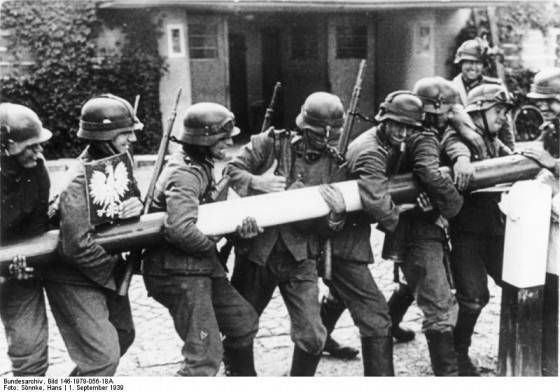
In the conventional wisdom, the 1 of September 1939 of the year began the Second World War - the Third Reich attacked Poland, although in China they count from the 1937 of the year. In 4 hours 45 minutes at the mouth of the Vistula River, the old German battleship Schleswig-Holstein opened fire on Polish military warehouses of Westerplatte in Danzig, the Wehrmacht launched an offensive along the entire line of the border.
Poland at that time represented a rather artificial state formation - created from the Polish territories proper, fragments of the Russian Empire, the German Empire and Austria-Hungary. In 1939, from 35,1 million people of Polish population of Poland there were 23,4 million people, Belarusians and Ukrainians — 7,1 million people, 3,5 million Jews, 0,7 million Germans, 0,1 million Lithuanians, 0,12 million Czechs. And the Belarusians and Ukrainians were in the position of oppressed slaves, and the Germans sought to return to the Reich. On occasion, Warsaw was not averse to incrementing the territory at the expense of its neighbors - in the 1922, the Vilna district captured, in 1938, the Cieszyn region in Czechoslovakia.
In Germany, they were forced to take territorial losses in the east - West Prussia, part of Silesia, the region of Poznan, and Danzig, mostly populated by the Germans, was declared a free city. But public opinion regarded this loss as a temporary loss. Hitler initially did not focus on these territories, considering that the problem of the Rhineland, Austria, the Sudetenland is more important, and Poland even became an ally of Berlin, getting crumbs from the master's table (Teszino region of Czechoslovakia). In addition, in Warsaw they hoped, in alliance with Berlin, to go on a campaign to the East, hoping to create a "Great Poland" from the sea (Baltic) to the sea (Black Sea). October 24 The Polish ambassador to Germany, Lipsky, was asked to accept Poland’s consent to include the free city of Danzig in the Reich, and Poland was offered to join the Anti-Comintern Pact (directed against the USSR, it included Germany, Italy, Japan, Hungary), in the course of later negotiations, Warsaw promised the territory in the East, at the expense of the USSR. But Warsaw has expressed his eternal stubbornness and constantly denied Reich. Why were the Poles so self-confident? Apparently, they had full confidence in the fact that London and Paris they do not give up and will help in the event of war.
Poland at that time led an extremely wise policy, having quarreled with almost all its neighbors: they did not want help from the USSR, although Paris and London tried to agree on this matter, there were territorial disputes with Hungary, they seized Vilnius from Lithuania, even with 1939 formed in March year, Slovakia (after the German occupation of the Czech Republic) had a fight - trying to seize from her part of the territory. Therefore, in addition to Germany, in September 1939 of the year, Slovakia also attacked Poland — they deployed 2 divisions.
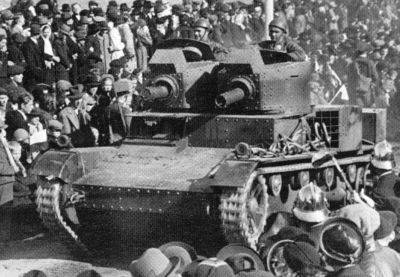
The Polish Vikkers E enters the Czechoslovak Zaolzie, October 1938 of the year.
France and England gave her a guarantee that they would help, but the Poles had to hold on for a week or two so that France would complete mobilization and concentrate forces for the strike. It is official, in reality in Paris and London they did not intend to fight with Germany, thinking that Germany would not stop and move on, against the USSR, and the two enemies would come together.
The disposition of opposing forces on 31 August 1939 of the year and the Polish campaign 1939 of the year.
Plans, parties
Poland began covert mobilization since March 23, 1939, managed to mobilize for war: 39 divisions, 16 separate brigades, only 1 million people, about 870 tanks (most of the wedges), a certain number of armored vehicles, 4300 guns and mortars, up to 400 aircraft. In addition, the Poles were sure that from the very beginning of the war they would support them with all their might. aviation Allies and Navy of Great Britain.
They planned to conduct a two-week defense, to restrain the Wehrmacht along the entire length of the border - almost 1900 km, against East Prussia, in favorable conditions, they even hoped to launch an offensive. The plan of the offensive against East Prussia was called the “West”, it was to be conducted by the operational groups “Narev”, “Wyszków” and the army “Modlin”. In the "Polish corridor", which divided East Prussia and Germany, they concentrated the Pomosha army, which, in addition to defense, was to capture Danzig. The Berlin direction was defended by the Poznan army, the border with Silesia and Slovakia was covered by the Lodz army, the Krakow army and the Karpaty army. In the rear of the south-west of Warsaw unwrapped auxiliary army "Prusy". The Poles stretched their orders across the border, did not create a powerful anti-tank defense in the main areas, did not create powerful operational reserves for flank attacks on the enemy that had broken through.
The plan was intended to several "ifs": if the Polish army will last two weeks on the main positions; if the Germans concentrated a small part of their forces and assets (especially aircraft and tanks) - the Polish command expected that Berlin would leave a significant grouping in the west; if in two weeks the Anglo-French forces launch a major offensive. Another weak point of the Polish army was to guide it from the very beginning of the war, thought only of his own skin. Small wonder that with such a command of the Polish Army lasted for almost a month.
Germany, against Poland The Third Reich deployed 62 divisions (of which 40 personnel first-strike divisions, of which 6 tank and 4 mechanized), total 1,6 million, about 6000 guns, 2000 aircraft and 2800 tanks (of which more than 80% light, wedges with machine guns). The German generals themselves assessed the infantry's combat capability as unsatisfactory, and they also understood that if Hitler was mistaken and the Anglo-French army struck in the west, then a catastrophe was inevitable. Germany is not ready to fight with France (its army at that time was considered the strongest in the world) and England, they had superiority at sea, in the air and on land, the defenses were not prepared ("Siegfried Line"), the western front was bare.
The Polish army planned (White Plan) to destroy with a powerful blow the maximum number of troops and assets within two weeks (the idea of a "blitzkrieg"), due to the exposure of the western border. Poles wanted to defeat earlier than in the west will be able to go on the offensive, creating a strategic turning point in the war. At this time, the western border covered 36 understaffed, almost untrained divisions, devoid of armored vehicles and aircraft. Almost all the tanks, armored vehicles were concentrated in five buildings: 14-m, 15-m, 16-m, 19-m and mountain. They had to find weak spots in the defense of the enemy, to overcome the defense of the enemy, to go to the operating room, entering the enemy in the rear, at this time infantry divisions fettered the enemy along the front.
Army Group North (4-I and 3-I army) beat from Pomerania and East Prussia in the general direction of Warsaw, so that by connecting with units of Army Group South to the east of Warsaw, close the encirclement of the remaining Polish troops north of the Vistula. Army Group "South" (8, 10, 14-I army) beat from the territory of Silesia and Moravia in the general direction to Warsaw, there was supposed to be connected with parts of the army group "North". 8-I army beat in the direction of Lodz, 14-I had to take Krakow, to attack Sandomierz. In the center there were weaker forces, they were supposed to pin down the Polish Poznan army with battles, imitate the direction of the main attack.
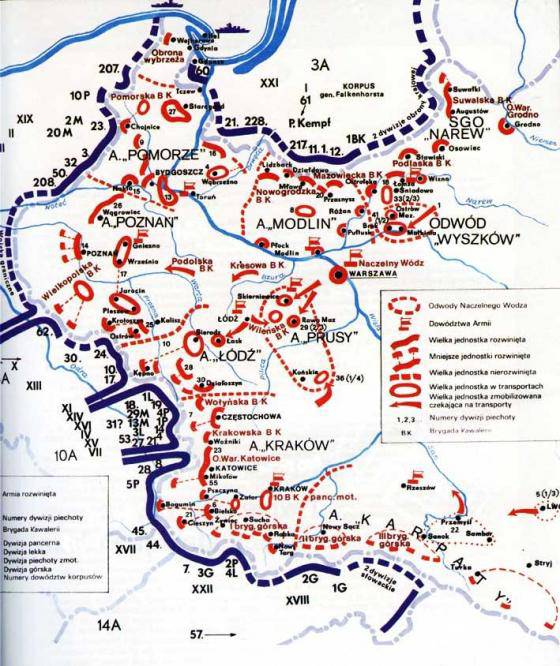
The deployment of troops on 01.09.1939 year.
Occasion
In order to observe the appearance of supposedly retaliatory actions, the German security services organized a provocation - the so-called “Gleuvitsky Incident”. On August 31, SS fighters and Polish prison criminals specially selected in prisons attacked a radio station in German Gleywitz. After seizing the radio station, one of them in Polish read a specially prepared tex on the radio, provoking Germany to war. Then the SS fighters shot the criminals (one of the names of the operation is “Canned Food”), threw them on the spot, they were discovered by the German police. At night, the German media said that Poland attacked Germany.
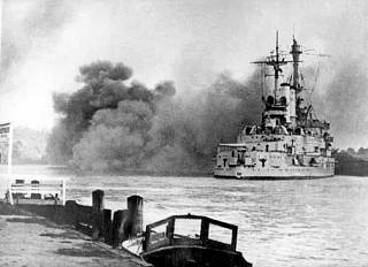
The first shots of a new war, the training battleship "Schleswig-Holstein".
War
The Luftwaffe during the first day destroyed most of the Polish aviation, and also violated communications, control, and the transfer of troops by rail. German shock groups quite easily broke through the front and went further, which is not surprising when the Polish units were dispersed. Thus, the 19 th mechanized corps (one tank, two mechanized, two infantry divisions), which beat Pomerania, broke through the defense of the 9 division and the Pomeranian cavalry brigade, having passed 1 km by the evening of September. In the Danzig Bay, the German Navy destroyed a small Polish squadron (one destroyer, one destroyer and five submarines), before the outbreak of the war three destroyers left for England, and two submarines were able to break through from the Baltic (later they fought in the British Navy).
Already on September 1, the President left Warsaw, 5 was followed by the government, so began their relocation to Romania. The last order, the “heroic” commander in chief of the Polish army, Edward Rydz-Smigly, issued 10, didn’t contact him, and then appeared in Romania. In his last orders, he ordered Warsaw and Modlin to keep the defense surrounded, the remnants of the army to keep the defense near the border with Romania and wait for the help of England and France. Rydz-Smigly 7 arrived in Brest on September, where they should have prepared the headquarters in case of war with the USSR, but it was not prepared, 10 arrived in Vladimir-Volynsk, 13 in Mlynov, and 15 September - closer to Romanian border, in Coloma, where were the government and the president.
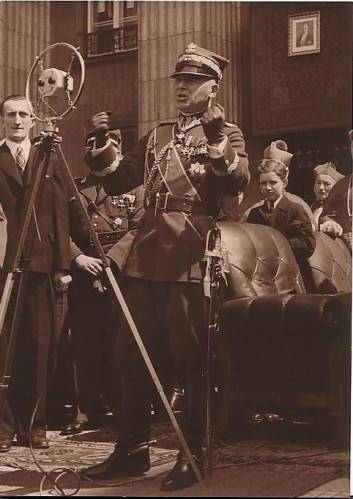
Marshal of Poland, Supreme Commander of the Polish Army Edward Rydz-Smigly.
The Pomogh army defending the Polish Corridor, 2, was cut by counter blows from East Prussia and Pomerania, its main part, coastal, was surrounded. In the southern direction, the Wehrmacht found the junction of the Lodz and Krakow armies, the 1-I tank division rushed into the breakthrough, leaving the rear of the Polish units. The Polish command decides to withdraw the Kraków army to the main line of defense, and the Лód на army to the east and southeast beyond the Nida and Dunajec river line (approximately 100-170 km). But the border battle was already lost, from the very beginning it was not necessary to defend the entire border, but to concentrate troops on the main axes, to create operational reserves for counterattacks. The defense plan of the Polish command was disrupted; in the north, units of the Wehrmacht advancing from East Prussia broke the resistance of the Modlin army to the 3 day, its remnants retreated beyond the Vistula. A different plan was not, could only hope for the Allies.
4-th Poles in the center went to the Warta River, but could not stay there, almost immediately they were shot down by flank blows, and the 5-th remnants of the parts go to Lodz. The main reserve of the Polish armed forces — the Prusa army — was disorganized and simply “dissolved”, by September 5 the war was lost, the Polish army was still fighting, retreating, trying to gain a foothold on some frontiers, but ... Polish units dissected, lost control, did not know what to do, got surrounded.
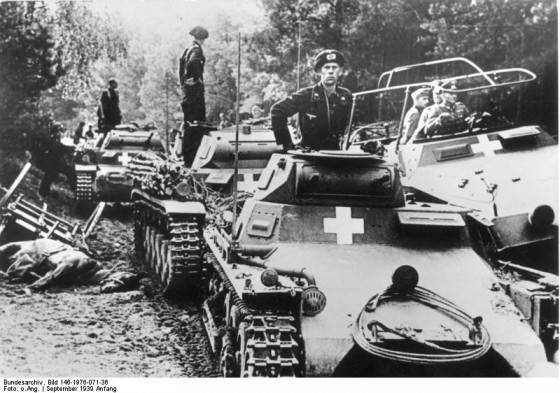
German tanks T-1 (Light tank Pz.Kpfw. I) in Poland. 1939 year.
September 8 began the battle for Warsaw, its defenders fought until September 28. The first attempts to take the city on the move, 8-10 of September, the Poles fought off. The command of the Wehrmacht decided to abandon the plan to take the city on the move and continued to close the blockade ring - 14-th ring closed. The Germans offered to capitulate to 15-16, the Polish military asked 17 for allowing the evacuation of civilians, Hitler refused. 22-th began a general assault, 28-th, having exhausted the possibilities of defense, the remnants of the garrison capitulated.
Another group of Polish forces was surrounded west of Warsaw - around Kutno and Lodz, they lasted until 17 on September, surrendering after several attempts at a breakthrough and when food and ammunition ran out. October 1 surrendered to the Baltic naval base Hel, the last center of defense was eliminated in Kock (north of Lublin), where October 6 capitulated 17 thousand Poles.
14 September 1939.
Polish Cavalry Myth
With the filing of Guderian, a myth was created about the attacks of Polish cavalry against Wehrmacht tanks. In reality, horses were used as vehicles (as in the Red Army, in the Wehrmacht), reconnaissance was on horseback, and the soldiers of the cavalry fought on foot. In addition, cavalrymen, because of their mobility, excellent training (they were the elite of the army), and good armament (they were reinforced with artillery, gunners, armored vehicles) turned out to be one of the most combat-ready units of the Polish Army.
In this war, only six cases of attack in the equestrian system are known, in two cases there was armored equipment on the battlefield. On September 1, under the Kroyantami, parts of the 18 of the Pomeranian Uhlan regiment were met by a Wehrmacht battalion on halt and, taking advantage of the surprise factor, attacked. Initially, the attack was successful, the Germans were caught by surprise, they were hacked, but then German armored cars intervened in the battle, which the Polish intelligence officers did not notice, and the battle was lost in the end. But the Polish cavalrymen, having suffered losses, retreated to the forest and were not destroyed.
On September 19, under Wulka, Wenglovoy, commander of the 14 regiment of Yazlovetsky ulan Colonel E. Godlevsky (he was joined by the 9 regiment of the Malopolsky ulan regiment) decided to break through the German infantry in equestrian ranks, relying on the surprise factor towards Warsaw. But this turned out to be the position of the motorized infantry of a tank division, and besides artillery and tanks were not far away. Polish cavalrymen broke through the positions of the Wehrmacht, losing approximately 20% of the regimental personnel (at that time, 105 people were killed and 100 wounded). The battle lasted only 18 minutes, the Germans lost 52 people killed and 70 wounded.
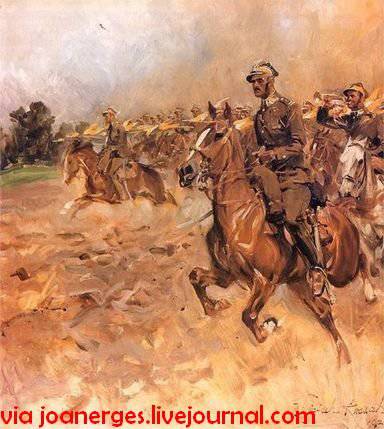
Attack Polish ulan.
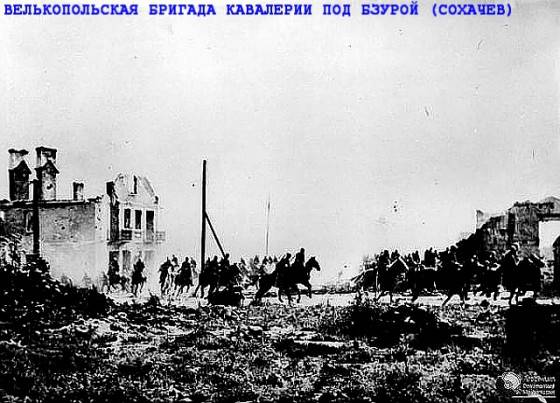
Results of the war
- Poland, as a state, ceased to exist, most of its territories were divided between Germany and the USSR, and Slovakia received some lands.
- On the remnants of the lands not joined to Germany, a governorship-general was created under the control of the German authorities, with the capital in Krakow.
- Lithuania retired Vilnius region.
- The Wehrmacht lost 13-20 thousand people killed and missing, about 30 thousand wounded. Polish Army - 66 thousand killed, 120-200 thousand wounded, about 700 thousand prisoners.
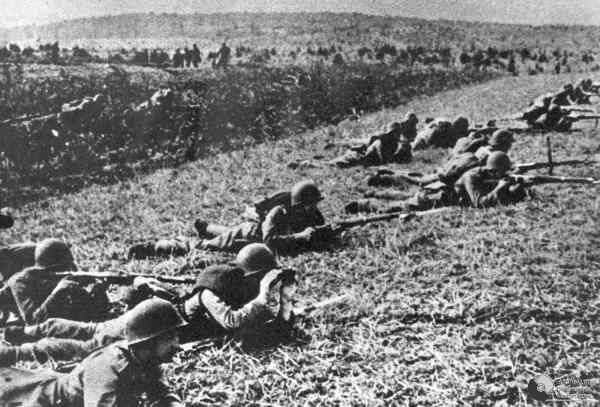
Polish infantry in defense
Sources of:
Halder F. Military Diary. Daily records of the Chief of the General Staff of the Ground Forces 1939-1942. (in 3-x volumes). M., 1968-1971.
Guderian G. Memoirs of a Soldier. Smolensk, 1999.
Kurt von Tippelskirch. History World War II, St. Petersburg., 1998.
Meltyukhov MI Soviet-Polish wars. Military-political confrontation 1918 — 1939 M., 2001.
http://victory.rusarchives.ru/index.php?p=32&sec_id=60
http://poland1939.ru/
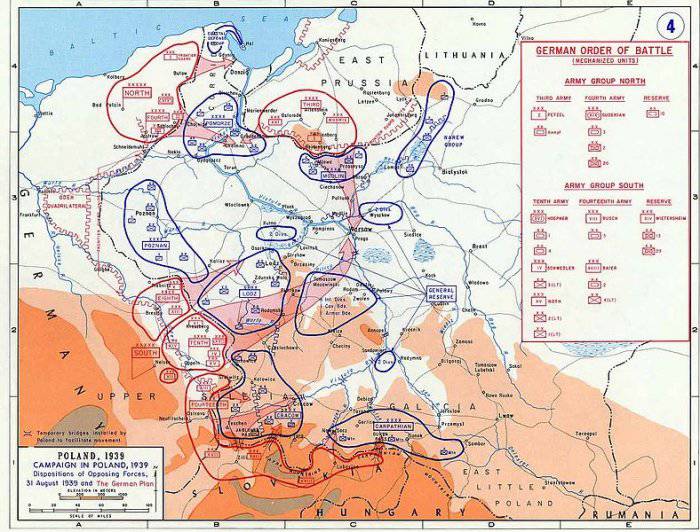
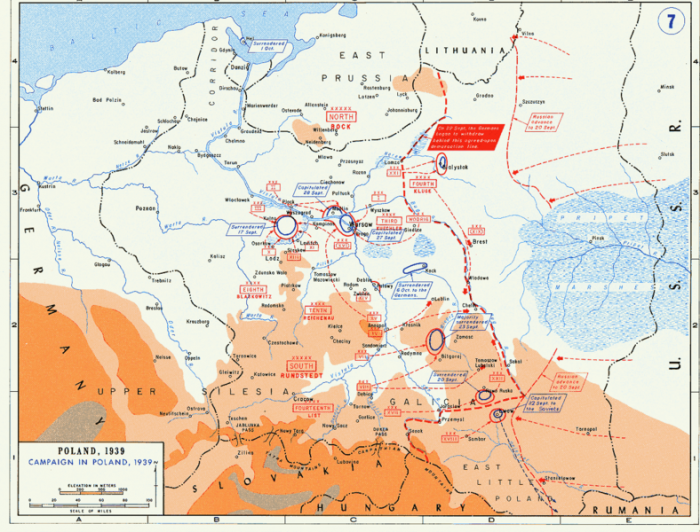
Information